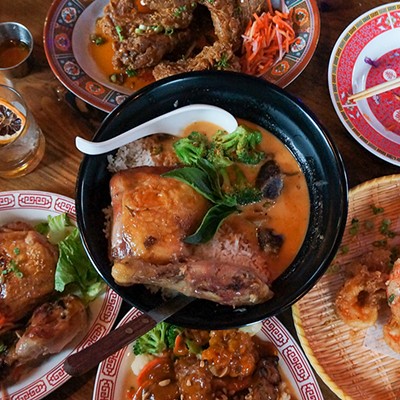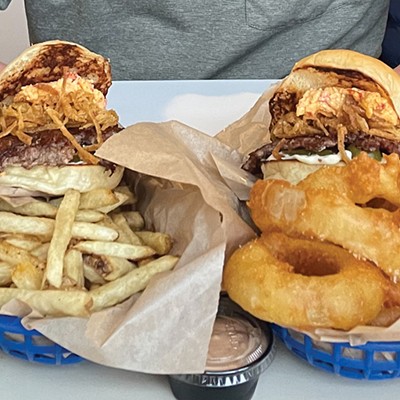When I was 18, I had a solar-powered smoothie cart here in Bend. Every morning I'd wheel my cart off the trailer hitch of my '87 Four Runner, push with all my might to get it up the sidewalk ramp, then lift the solar panels into position. Next to Starbucks downtown by the bench with the statue of a man—his wallet open—I would eagerly blend frozen fruit and juice, sure I could change the world, one smoothie at a time.
It was the beginning of the "health" boom, or so I thought. I was sure that within a decade we would recognize that “real” food was affordable. Nutrient rich food was marketable. And consumers could force the McDonalds of the world to offer healthier choices in smaller portions.Boy was I wrong! Sixteen years later I am much more of a realist. But I’m happy to see that at least here in Bend, local food trends are moving in healthier directions. Away from the giant portions of the past. Away from processed foods packed with fat and sugar but not much else. Toward fresher, organic, more nutrient-rich whole foods to keep us lean and give us fuel for our active lifestyles.
WHERE DO WE WEIGH IN?
Compared to the rest of the nation, Central Oregonians are already a slightly healthier bunch.
According to the Oregon Health Authority, the obesity rate for the population of Deschutes County was about 17% in 2007, compared to 26% for all Oregonians and 35% as a national average. Oregon's kids have the lowest obesity rate in the nation. Unfortunately adults in Oregon have continued to test their waistbands—between 1990 and 2009, Oregon obesity rates jumped 121%.
WHAT’S THE HARM?
The health implications of obesity are alarming, including increased risk for preventable diseases such as high blood pressure, type 2 diabetes, heart attack and stroke, cancer, and arthritis. According to the Oregon Health Authority, obesity contributes to the deaths of about 1400 Oregonians per year. Only tobacco use beats it as a leading cause of preventable deaths.
What’s even more startling are the financial implications. O.H.A. reported that “medical costs in Oregon related to obesity among adults reached $1.6 billion in 2006,” and that “obese persons are estimated to have annual medical costs that are $1,429 higher than non-obese person.”
KEYS TO EATING HEALTHY
But what exactly is "healthy" eating? Should we panic if it's not organic? That depends on who you ask, of course. But most of us can agree that eating a variety of fiber-rich foods full of vitamins and minerals is the safest way to go.
Fresh and living fruits and vegetables contain enzymes that help our bodies break down and utilize nutrients from the food we eat. Fiber helps to remove the debris and toxins that result when our bodies break down food. The more enzyme-rich foods full of fiber we consume—like fruits and vegetables—the better we look, the better we feel, and the better our bodies become equipped to handle stress and fight off sickness and disease.
Unfortunately, according to OHA, “Only about one fourth of adult Oregonians eat recommended amounts—five or more servings per day—of fruits and vegetables.”
WHERE TO EAT WHEN YOU CARE
Sarah's Superfood Smoothie uses only fruits, vegetables, uncooked grains and nuts, and an apothecary of superfoods like blue-green algae, spirulina, acai and goji berries to create nutrient packed smoothies and entrees using fresh and raw ingredients. A firm believer in a "raw" diet, rich in vitamins, minerals and the enzymes normally lost during cooking, she has inspired many locals to change for the better through her raw food cooking classes and quarterly guided cleanses. During the six week cleanse, she supplies the supplements, recipes and coaching needed to adopt healthier habits. I’ve met several people who have participated in her cleanses, all of whom have not only lost weight and gained energy, but some have begun to reverse serious diseases such as auto-immune disorders, thyroid dysfunction, diabetes, and chronic pain.
Alpenglow Cafe has been a long-lived fresh food favorite here in Bend. Nothing they serve is frozen or canned and almost every ingredient used comes from trusted Oregon sources. Cafe Yumm was our first corporate chain with a conscience. Serving various combinations of rice, beans and veggies, select meats and vegetarian proteins, Cafe Yumm offers quick and affordable food that will fill you up without filling you out.
Chow, and Mother's Juice Cafe were welcome additions to the westside food scene, both of which create their menus around fresh and mostly organic foods. Jackson's Corner steps it up a notch by offering almost exclusively Oregon-grown produce and locally-raised meats. Even our street vendors are offering smart choices. Food carts such as Spork and Real Food offer many low-fat options with lean proteins and veggies, both with and without meat
Westside newbie Broken Top Bottle shop is a great example of the trend towards plant-based diets. Over half the menu boasts vegetarian and vegan options.
Several fine dining restaurants have also joined the trend, setting themselves apart by serving a multitude of nutritious and flavorful low-fat entrees in addition to the classically rich dishes we still demand. Zydeco and 900 Wall offer outstanding vegetarian entrees and vegetable side dishes, and most of their respective menus can be enjoyed gluten-free. Common Table and Ten Below are two other downtowners who do a great job of incorporating a wide array of seasonal vegetables and unprocessed foods into their menus.




















